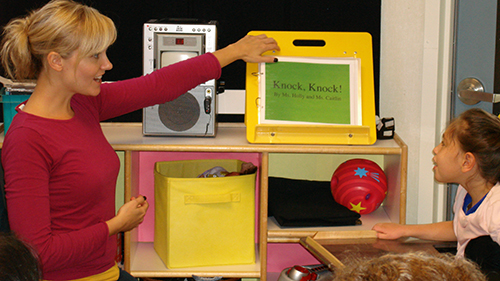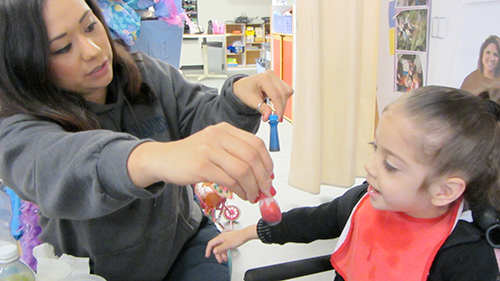Students require repeated practice in naturalistic contexts with multiple partners in order to build communicative competence skills (Blackstone, 2008). Educators use a variety of practices and procedures to create frequent and motivating communication opportunities. Many of these strategies come from enhanced milieu teaching, which focuses on embedding communication opportunities within typical classroom activities by following the child’s attentional lead, interacting responsively and arranging the environment to increase student engagement.
Following the child’s lead is a technique where the adult observes the child and identifies what their attention is focused on and/or what they are interested in, and then engages with the child around the student’s interest. The focus is on having the student lead the interaction with the adult joining in and talking about objects, events and relations that have attracted the child’s attention.
Arranging the environment involves the selection and use of materials, layout of the physical space and the structure of activities and routines. Providing interesting materials that encourage social and interactive play and cooperation can naturally create communication opportunities. Identifying preferred materials and activities and providing them to students can increase levels of engagement and create reasons for students to communicate for a range of purposes (e.g., requesting a favorite toy). Providing play and learning areas that accommodate small groups can create peer proximity that encourages social interactions between students. Establishing routines for repeated activities in regular locations can help students learn to anticipate upcoming activities based upon where they are in the classroom.

Arranging classroom materials in consistent, predictable locations support context-dependent communicators as they learn to communicate for a range of purposes.

Collin’s preferred visual field is on his left, so partners are positioned where he can easily reference them for social communication. Peer proximity encourages social interactions between students.
Communication tools are infused within familiar, motivating locations and activities. Will is learning to ambulate over to a computer station, a preferred activity. A single message communication tool with the message “Can I play on the computer?” helps Will learn to communicate a request within temporal and spatial proximity to the requested activity.
Commenting and asking questions encourages children to talk about their actions and express their feelings and opinions. Commenting on student activities demonstrates adult interest and engagement in what the student is doing and what he or she cares about. Open-ended questions are those questions that do not dictate a specific form in the response (e.g., “Tell me about…” or “Now what?”). Open-ended questions have a variety of possible answers. In contrast, closed-set or test questions dictate a specific answer from a set of options and are not as supportive to language and communication development as open-ended questions. Wh-questions (e.g., Who, What, Where, Why) contain a specific “question word” and thus elicit a response to match the type of question asked.
Offering choices between at least two different options is an easy and effective technique to provide students with opportunities to express their preferences and learn to make requests. Offering numerous choices during interactions can establish and extend student engagement in activities as well as promote self-determination skills. In an elicited offered choice, the adult initiates an interaction (e.g., by asking “What do you want?”) and offers two or more clearly-defined options and the student responds to indicate their desired choice (Sigafoos and Mirenda, 2002). A binary choice is a choice between two items or options.


Dana offers Aidan 3 choices of photos to use in his writing. She allows him plenty of time to become familiar with the options before asking him to make his choice.
Blocked response/interrupted behavior chain occurs when the adult interrupts a student’s on-going activity such that a need for communicating a request is created (e.g., preventing a student from moving towards the ball, creating a need for the student to request to play more).
Sabotage (also known as missing item format) occurs when the adult provides materials that are difficult to operate or provides inadequate portions of desired or needed materials, such that the student is motivated to communicate to request assistance or request a needed item.
Communicative temptations involve setting up situations in which the student is likely to be motivated to communicate (Iacono, et al, 1998). Examples of this technique include: activating a wind-up toy, letting it de-activate, and then placing it in front of the child; eating a food item in front of the student without offering any; and initiating a familiar or unfamiliar social game with the student until he or she expresses pleasure, then stopping the game and waiting for a communication signal.
Physical Proximity refers to when a partner adjusts their physical closeness to a student during an interaction. Close proximity can be used to let the student know you are nearby and ready for them to initiate an interaction and proximity helps maintain active engagement during the interaction. In this strategy, a communication partner will get close enough to a student so they are in the student’s best visual field, while still maintaining personal space (a comfortable distance away from one’s partner). Appropriate proximity helps beginning communicators focus on their communication partner and remain more engaged in the exchange rather than becoming distracted by other stimuli.